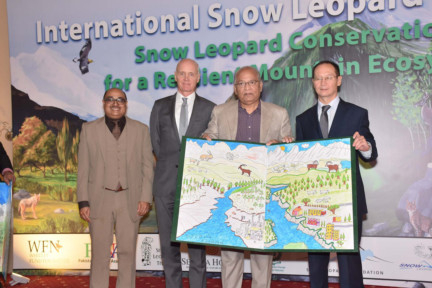
Islamabad
High in the Himalayas live one of the world’s most beautiful and enigmatic cats — the snow leopard.
The progeny of the snow mountains, cherished for its beautiful, thick white-grey fur and dark rosettes, is also known as the ‘ghosts of the mountains’ because it is rarely seen by humans.
Sadly, only 3,000 to 7,500 snow leopards remain in the wild throughout the world as these big cats are poached for their fur and bones.
Present in only 12 countries in Central and South Asia including Pakistan, the snow leopard face extinction because of degraded habitat, illegal wildlife trade and climate change.
Still faces extinction
To protect these elusive cats from poachers and changing weather patterns, Pakistan is stepping up conservation efforts to improve the status of the snow leopard which is no longer an endangered species but still faces extinction.
This wildcat is found in Pakistan’s 81,000 square kilometres of Hindu Kush, Pamir, Karakoram and Himalayan Mountain ranges. With an estimated population of 200 cats, Pakistan is home to the world’s third largest snow leopard population.
Pakistan has now developed a protection plan for snow leopards. “Pakistan has endorsed the Global Snow Leopard Ecosystem Programme (GSLEP) by developing its National Snow Leopard Ecosystem Protection Priorities (NSLEP) and also joined other snow leopard range countries for achieving the goal of securing 20 landscapes by 2020,” says Federal Minister for Climate Change Senator Mushahid Ullah Khan.
The Ministry of Climate Change has involved all the provinces and relevant stakeholders while planning the conservation strategy which would be initiated in April 2018, he said.
Pakistan has recently allocated $4.5 million (Dh16.51 million) to launch a protection programme in Gilgit-Baltistan region next year.
“Pakistan is an active member of the GSLEP process and had chaired the GSLEP steering committee for years. Three GSLEP model landscapes — Karakoram, Pamir, Himalayas and Hindu Kush — fall in Pakistan,” says Federal Secretary Ministry of Climate Change Syed Abu Ahmad Akif. Pakistan marked the International Snow Leopard Day on October 23, 2017, with several events and awareness programmes to engage local communities, especially youth. “We aim to establish information centres to promote awareness about snow leopards, prey species and the values of snow leopard ecosystem, and to engage youth in conservation activities,” Akif said.
The snow leopard conservation efforts in Pakistan date back to the early 70s with the government ratification of provincial wildlife acts. A number of wildlife conservation organisations have been working on the snow leopard conservation action plans lately.
One of the most notable figures is Dr Ali Nawaz, the winner of the Whitely Award known as the “Green Oscar”, for his efforts to conserve the snow leopard in Pakistan. Dr Nawaz, director of the Snow Leopard Foundation Pakistan, aims to bring together NGOs and the government to develop a multi-stakeholder strategy for this mountainous habitat.
“This will be Pakistan’s first landscape-level strategy for snow leopard conservation and will be used as a model to guide future conservation planning in Pakistan,” according to the Snow Leopard Trust. The project will train 50 wildlife managers and engage 6,000 herders to enable the coexistence of communities and carnivores.
The snow leopard habitat is currently found in Afghanistan, Bhutan, China, India, Kazakhstan, Kyrgyzstan, Mongolia, Nepal, Pakistan, Russia, Tajikistan, and Uzbekistan. Experts believe an estimated 3,000 to 7,500 snow leopards exist in the 12 countries and Pakistan is home to 200 of the big cats.













